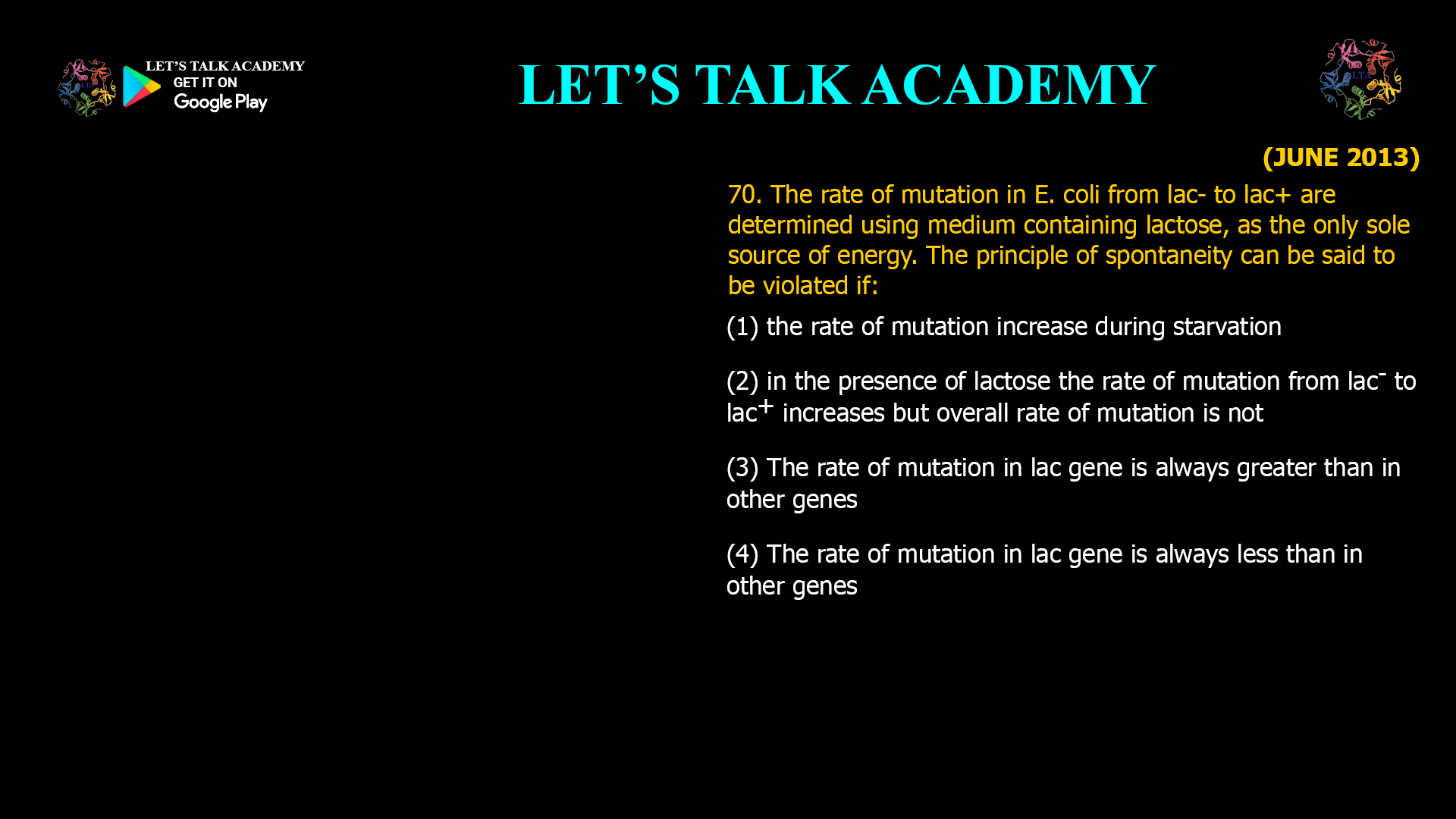- The rate of mutation in E. coli from lac– to lac+ are determined using medium containing lactose, as the only sole source of energy. The principle of spontaneity can be said to be violated if:
(1) the rate of mutation increase during starvation
(2) in the presence of lactose the rate of mutation from lac– to lac+ increases but overall rate of mutation is not
(3) The rate of mutation in lac gene is always greater than in other genes
(4) The rate of mutation in lac gene is always less than in other genesThe Principle of Spontaneity in Mutation
The principle of spontaneity states that mutations occur randomly and independently of selective pressures. In other words, environmental conditions do not direct or increase the rate of beneficial mutations; instead, mutations arise by chance, and selection acts on the resulting variation. This principle is foundational to modern genetics and evolutionary biology.
Measuring Mutation Rates in the lac Operon
To determine the mutation rate from lac- to lac+, E. coli is grown on a medium where lactose is the only source of energy. Only those bacteria that acquire a mutation restoring lac+ function can survive and grow. By counting the number of lac+ colonies that appear, scientists can estimate the mutation rate.
When Is the Principle of Spontaneity Violated?
Let’s analyze the possible scenarios:
1. The rate of mutation increases during starvation
If mutation rates were to increase specifically during starvation, it would suggest that environmental stress (starvation) is directly causing an increase in mutations, rather than mutations occurring randomly. This would challenge the principle of spontaneity, as it implies a directed or adaptive response in mutation rates, rather than random chance.
2. In the presence of lactose, the rate of mutation from lac- to lac+ increases but the overall rate of mutation is not
If the presence of lactose specifically increases the rate of mutation from lac- to lac+ (but not the overall mutation rate), it would suggest that the environment is somehow “directing” mutations to occur where they are beneficial. This would directly violate the principle of spontaneity, as it implies that beneficial mutations are more likely to occur when needed, rather than arising randomly.
3. The rate of mutation in the lac gene is always greater than in other genes
If the lac gene simply has a higher baseline mutation rate due to its sequence or structure (such as a mutational hotspot), this does not violate the principle of spontaneity. Mutational hotspots are well-documented and are a product of DNA sequence context, not environmental direction.
4. The rate of mutation in the lac gene is always less than in other genes
Similarly, if the lac gene has a lower baseline mutation rate compared to other genes, this is a property of the gene itself and does not violate the spontaneity principle.
Which Scenario Violates Spontaneity?
The principle of spontaneity would be violated if, in the presence of lactose, the rate of mutation from lac- to lac+ increases but the overall rate of mutation does not. This would mean that the environment is somehow increasing the likelihood of a specific, beneficial mutation rather than mutations occurring at random. Such a scenario would suggest a form of “directed mutation,” which contradicts the foundational understanding of genetic mutation as a spontaneous, random process.
Why Is This Important?
Understanding whether mutations are truly random or can be environmentally directed has profound implications for evolutionary theory. If mutations could be directed by environmental needs, it would require a fundamental revision of how we understand adaptation and evolution. However, decades of research, including classic experiments with the lac operon, have consistently supported the principle that mutations are random with respect to their utility.
Conclusion
The principle of spontaneity is central to genetics: mutations occur randomly, not in response to environmental need. The scenario where the rate of mutation from lac- to lac+ increases specifically in the presence of lactose, without a general increase in mutation rates, would violate this principle. Such directed mutation has not been supported by experimental evidence and remains outside the accepted framework of molecular genetics.
Correct answer:
(2) In the presence of lactose the rate of mutation from lac- to lac+ increases but overall rate of mutation is not



